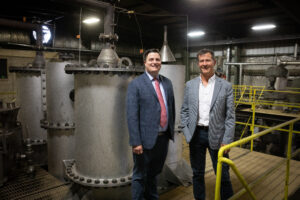 Each year, U.S. forestry and agriculture generates over 350 million tons of waste biomass including branches, leaves, and roots. In addition, U.S. households produce about 300 million tons of waste, half of which ends up in landfills. The Environmental Protection Agency (EPA) classifies biomass and sorted waste as renewable resources for production of green energy.
Each year, U.S. forestry and agriculture generates over 350 million tons of waste biomass including branches, leaves, and roots. In addition, U.S. households produce about 300 million tons of waste, half of which ends up in landfills. The Environmental Protection Agency (EPA) classifies biomass and sorted waste as renewable resources for production of green energy.
University of Utah chemical engineering professor Kevin Whitty believes there are effective methods to take that waste and produce one of the ultimate sources of clean energy — hydrogen.
Hydrogen is an energy source that emits no harmful carbon emissions. When used in a fuel cell or burned in a turbine to produce electricity, the only by-product is water.
Whitty has been awarded two separate grants from the U.S. Department of Energy, each for $2 million over two years, to develop methods to convert biomass and waste into pure hydrogen.
“There is a huge push from the DOE and the industrial sector to produce hydrogen from renewable sources,” Whitty said. “Hydrogen is attractive as a carbon-free fuel with potential for large-scale energy storage.”
The first project, which Whitty (pictured, right) and co-lead, U chemical engineering professor Michael Nigra (pictured, left), will be working on in conjunction with Idaho National Laboratory, centers on “sorption-enhanced gasification” (SEG), a promising technology to convert waste biomass to hydrogen in a single reactor system. In the SEG process, the biomass, which could be agricultural waste such as corn stover (the husks, stalks, and cobs that are left after the corn is harvested) reacts with steam in a high temperature reactor to produce hydrogen and carbon dioxide (CO2). A sorbent material such as calcium oxide from limestone is used to remove the carbon dioxide, leaving only hydrogen. The CO2 is recovered and can be compressed and stored deep underground, in effect removing carbon dioxide from the atmosphere via the biomass, a process known as biomass energy carbon capture and sequestration (BECCS).
“The idea has been shown to work at lab scale,” Whitty said. “But to push these types of technologies forward we must move towards industrial scale. This will be, I believe, the world’s largest demonstration of sorption-enhanced gasification to date.”
The second project, which involves several industrial partners, uses what is called “pressurized entrained-flow gasification.” The process involves converting waste such as biomass, non-recyclable plastics, discarded household goods and legacy coal tailings, into separate hydrogen and CO2 streams through a multi-step process.
The waste is first converted to a liquid slurry, which is then pumped into a high-pressure reactor where it reacts with oxygen to produce hydrogen and carbon monoxide gas. That gas goes through another process where it reacts with steam to turn the carbon monoxide into carbon dioxide and the steam into more hydrogen. The hydrogen and CO2 are separated using standard technology. This whole process is self-powered using the same waste you are converting, Whitty said.
While there are thoughts of hydrogen-powered cars, that kind of technology is unlikely to become mainstream any time soon, he said. These technologies to produce hydrogen for large-scale energy storage can benefit power grids for cities and towns and supply energy for industrial use.
The U.S. Department of Energy is betting big on hydrogen energy, investing $8 billion to establish four hydrogen hubs in the country as part of the Infrastructure Investment and Jobs Act, which was passed in 2021. Utah, Colorado, New Mexico, and Wyoming have proposed a coalition called the “Western Inter-States Hydrogen Hub” (WISHH) to build facilities in each of the states.